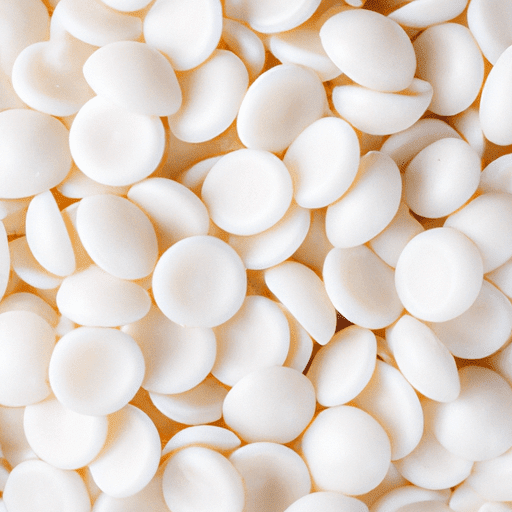The Delightful World of White Chocolate Morsels
If you have a sweet tooth and a passion for baking, then white chocolate morsels are sure to be your next best friend in the kitchen. These tiny, delectable drops of creamy goodness are an essential ingredient that can add a delightful touch to a variety of desserts. In this blog post, we dive into the world of white chocolate morsels, exploring their taste, common uses in cooking, nutritional value, and uncovering some interesting historical tidbits.
The Taste of Heaven
White chocolate morsels are made from a blend of sugar, cocoa butter, milk solids, and vanilla. Unlike their darker counterparts, white chocolate morsels lack cocoa solids, giving them their distinct pale color. When you pop one into your mouth, you’ll experience a smooth, buttery texture that melts on your tongue, leaving behind a rich and sweet flavor with subtle hints of vanilla. The luxurious creaminess and delicate sweetness make it an irresistible treat for dessert lovers around the world.
Versatile in the Kitchen
White chocolate morsels are a versatile ingredient that can be used in a wide range of culinary creations. From classic cookies to decadent cakes and delightful ice creams, their presence adds a unique touch to any recipe. One of the most popular uses of white chocolate morsels is in baking cookies, where they not only add sweetness but also create delightful pockets of melted creaminess. You can also use them to make luscious mousses, velvety smooth frostings, or even melt them down for chocolate-dipped strawberries. The possibilities are truly endless!
A Peek into the Nutritional Profile
While white chocolate morsels bring a burst of flavor to your desserts, it’s essential to consider their nutritional value. Compared to their dark and milk counterparts, white chocolate morsels have a higher fat and sugar content. While this means you should enjoy them in moderation, they still offer some benefits. They contain calcium, which is essential for healthy bones and teeth. Additionally, the cocoa butter present in white chocolate morsels contains healthy fats known to improve good cholesterol levels. Nonetheless, it’s worth keeping in mind that white chocolate morsels are not significant sources of other vital nutrients like iron or fiber.
A Sweet History to Discover
The origins of white chocolate can be traced back to the early 1930s, when a Swiss chocolatier named Nestlé introduced it to the world. However, it wasn’t until the 1970s that white chocolate morsels gained popularity in the United States, when the “Premier White Morsels” were introduced by Nestlé’s Toll House brand. Since then, white chocolate morsels have become a staple in American kitchens, beloved for their tantalizing taste and versatility.
White chocolate morsels are a delightful addition to any kitchen. With their smooth and luscious texture, heavenly taste, and wide range of uses, they can elevate your desserts to new heights. Whether you’re baking classic cookies, preparing beautiful cakes, or experimenting with innovative recipes, these tiny drops of creamy sweetness are sure to delight your taste buds and impress your guests. So, the next time you’re craving something sweet, reach for a bag of white chocolate morsels and let your culinary imagination run wild!
Facts about White Chocolate Morsels:
Origin: White chocolate is believed to have been invented by the Swiss company Nestlé in the 1930s. Its creation is credited to Rudolf Lindt, who developed the conching process, which is used to produce smooth and creamy chocolate. However, some argue that white chocolate has a longer history, as a similar type of sweet called “Vanilla Chocolate” was made in Europe in the late 1800s.
Composition: Unlike other types of chocolate, white chocolate does not contain cocoa solids. It is made from cocoa butter (the fat extracted from cocoa beans), sugar, milk solids, and flavorings like vanilla. The absence of cocoa solids gives white chocolate its signature creamy color.
Common Uses: White chocolate morsels are most commonly used in baking. They are often added to cookies, cakes, muffins, and other sweet treats to provide a rich and creamy flavor. White chocolate can also be used in confectionery, ice cream, or as a decorative drizzle on desserts.
Nutritional Benefits: White chocolate contains a good amount of calcium and phosphorus due to its milk content. However, it is important to note that white chocolate is high in fat and sugar, so it should be consumed in moderation as part of a balanced diet.
Properties: White chocolate has a smooth and buttery texture. It has a delicate and sweet flavor with notes of vanilla. Due to its high cocoa butter content, white chocolate has a lower melting point compared to other chocolates. This makes it great for melting, dipping, or coating various confections.
Historical Significance: White chocolate has historically been a controversial topic among chocolate enthusiasts. It does not meet the technical definition of chocolate, as it lacks cocoa solids. However, it is still widely used and enjoyed for its unique taste and creamy texture.




Use the share button below if you liked it.
It makes me smile, when I see it.